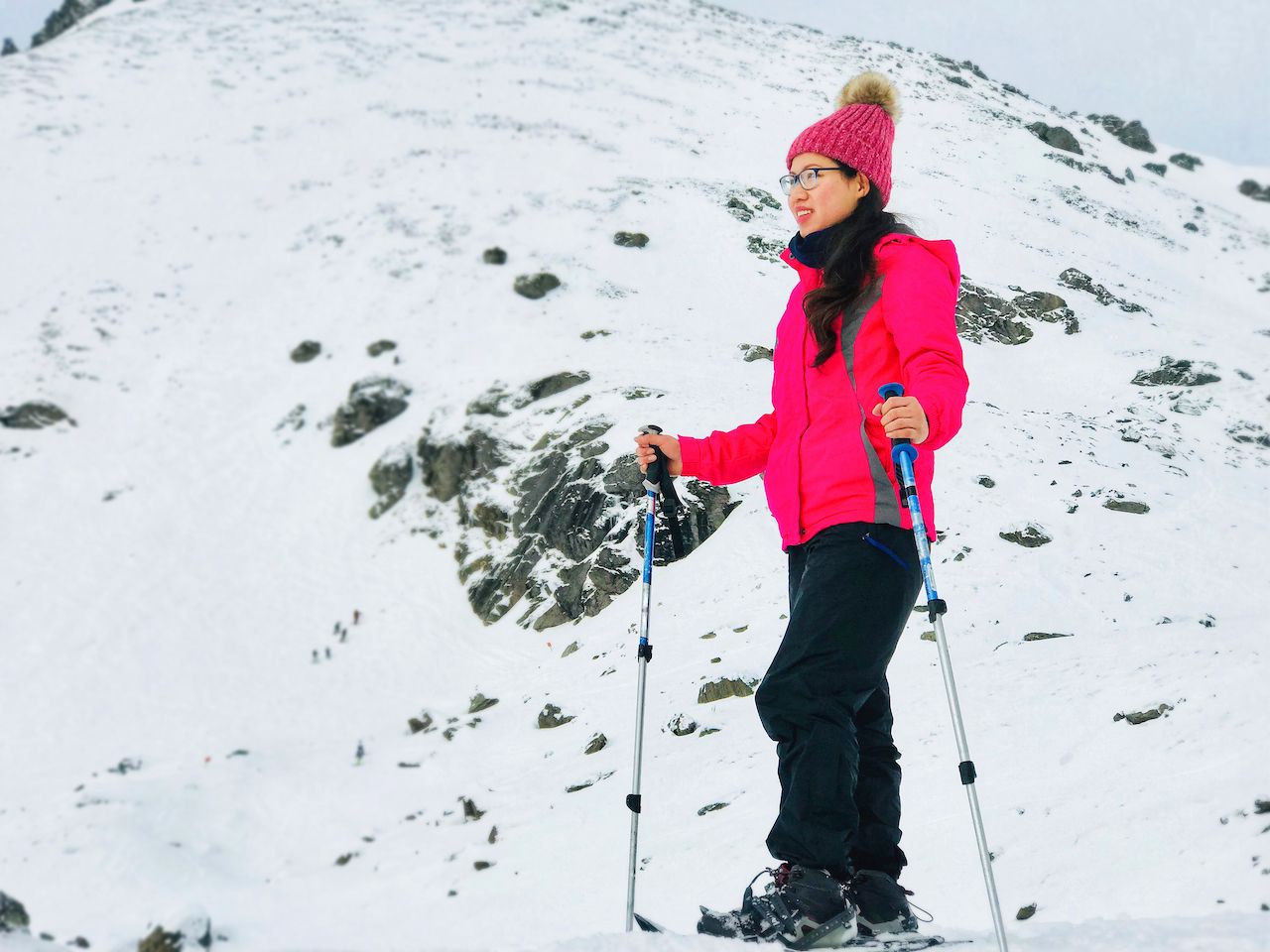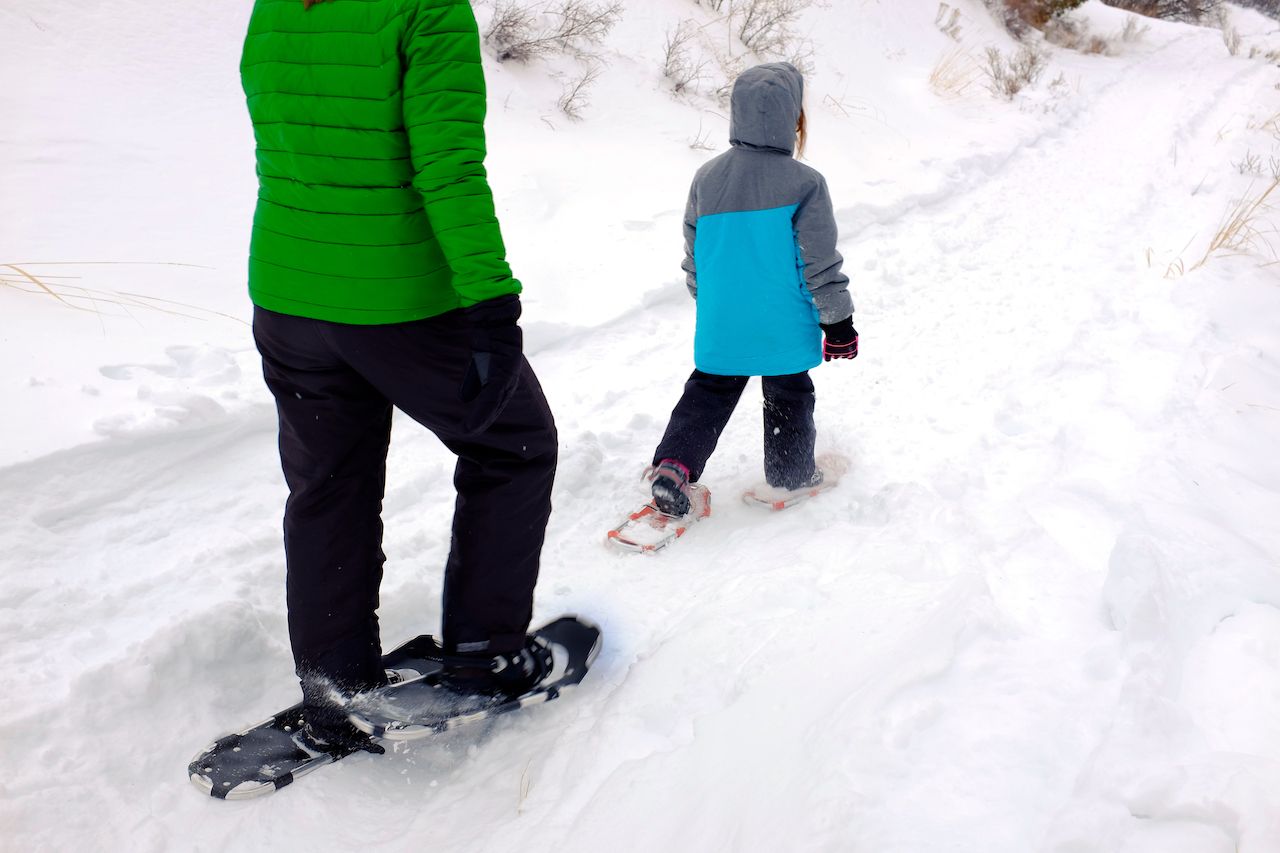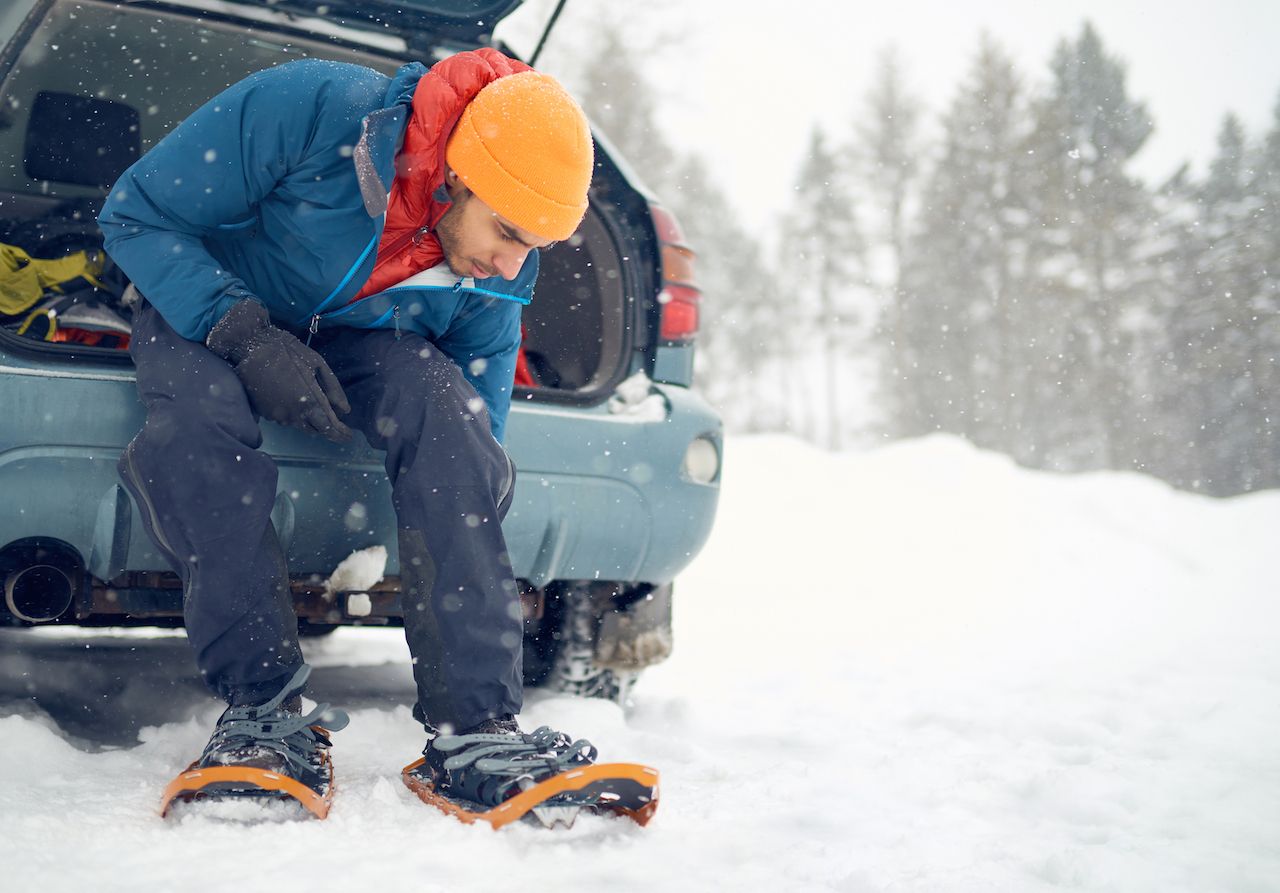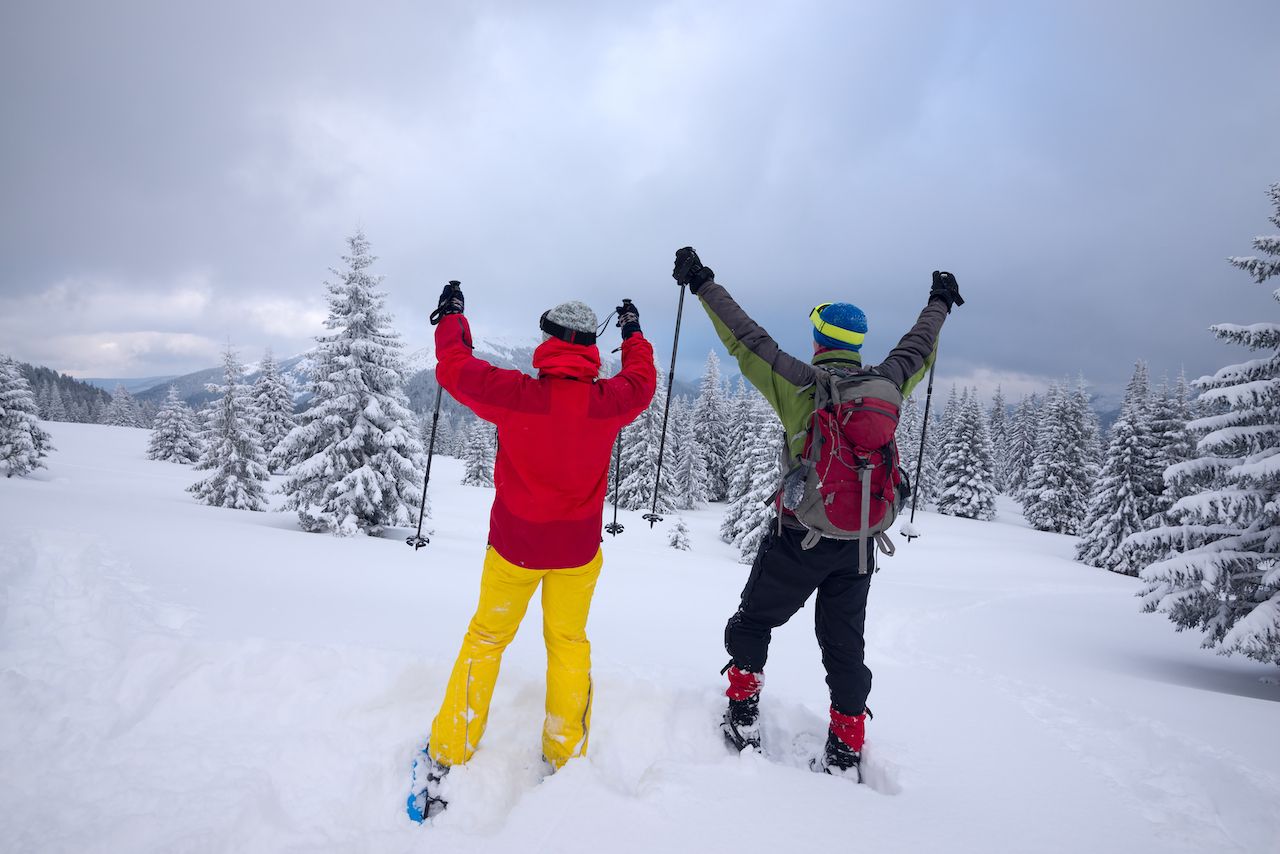We’ve found ourselves spending a lot of time outdoors this year, and there’s no reason we need to stop enjoying that fresh air once the snow falls. As long as there’s a natural area nearby, snowshoeing is one of the best ways to enjoy the trees, open spaces, and outdoor time with friends. It’s also an incredibly easy activity to get started doing.

Snowshoeing Is Easier, More Available, and More Fun Than You Thought
Why go snowshoeing?

Photo: Ho Su A Bi/Shutterstock
If you have a good pair of winter boots that are warm and waterproof, you may wonder why you even need a pair of snowshoes to get out and enjoy nature in winter. What snowshoes do is let you explore areas where the snow is too thick to walk in — or, at least, to walk in easily — with a pair of boots. When there’s a lot of snow, you’re likely to just sink into it with your winter boots.
Snowshoes, by being bigger than the bottom of your boots, spread out your weight across a larger surface area — so you won’t sink into the snow. With most snowshoes, your boots are only strapped into snowshoes on the front part, leaving the heel free. While walking this way takes a few moments to get used to, it means you don’t have to lift snowshoes quite as high and they can stay in contact with the snow longer. All this means that snowshoes permit you to cross snowy areas that might be difficult or impossible to traverse in boots alone.
That’s the technical reason for snowshoeing. The more philosophical case for it is that it’s just a wonderful way to enjoy winter’s natural landscapes and a great way to get out into nature with a friend or even a group of friends — and a lovely reminder of how people forged their way across snowy landscapes hundreds of years ago. Making your own trail through the trees or over a meadow atop a blanket of winter white is a magical experience, allowing you to explore areas that would be inaccessible without snowshoes. Snowshoeing can be a leisurely endeavor or, at a faster pace and longer distance, an excellent workout.
Where to snowshoe

Photo: Devansphotography/Shutterstock
The basic thing you need to snowshoe is simply snow. Obviously, you aren’t going to snowshoe down an urban street, because in no time at all the snow would be packed down, eliminating the need for snowshoes to get to the subway. However, you can snowshoe in cities. You just need to find a big enough park and to head out right after a snowfall. In NYC, you can actually snowshoe in Manhattan’s Central Park, Brooklyn’s Prospect Park, or Staten Island’s Greenbelt.
With the right conditions, you could also strap on snowshoes and explore pretty much any state park in New Jersey or on Long Island. Just outside Boston, try out the Boston Nature Center or Harold Parker State Forest. Snowshoeing is obviously popular throughout the Northeast, in its beautiful and quiet state parks and in such coveted destinations as Acadia National Park.
Snowshoeing options also abound in the Midwest, where you’ll find more exciting ways to celebrate winter than just about anywhere else. In Chicago you can snowshoe on Northerly Island or at the Morton Arboretum, while Kettle Moraine State Forest and Harrington Beach State Park are among the many places to snowshoe near Milwaukee.
Out west, plenty of snowshoeing opportunities abound in and around Denver, such as in Golden Gate State Park or Rocky Mountain National Park. While there’s not usually enough snow in Seattle to strap on a pair of snowshoes, you’re just a short drive away from the Cascade Mountain range and plenty of snowshoeing opportunities there.
Snowshoeing is usually available around most US ski resorts and is a great way to enjoy a ski trip even if you don’t ski. Often, popular snowshoe trails are the same ones cross-country skiers use. If that’s the case, get out of their way as they come by and be sure not to mess up their tidy, grooved ski tracks by stepping on them.
Better yet, get off the trail altogether. When you rent your snowshoes, just ask the folks there about the best places to head into, any areas to avoid (whether for bears, snowmobiles, or cliffs), and anything other key things specific to that area. And then get out there. Beautiful, cottony white landscapes are waiting to be explored.
First steps to snowshoeing

Photo: Lane V. Erickson/Shutterstock
Snowshoeing is incredibly easy to do and snowshoes are cheap to rent or buy. We’ll get to that inexpensive gear below, but we want to start with a few words on what to wear and know before you head out.
If you are only planning on a short excursion, or if you just plan to check out the natural expanse behind your house, just be sure you have waterproof boots and warm clothing. To snowshoe on flat ground, just put one foot in front of the other — albeit in a wide enough stance that your snowshoes don’t bang into each other. If you will do anything more than a short walk in the park, then plan on using poles as well.
Any outing longer than an hour requires a little more thoughtful consideration. Snowshoeing is a good workout, and you’ll find you need to be less warmly dressed than you would be if you were just walking or even skiing (which, while a workout, also cools you off with the wind and alpine temperatures). If you have ski pants and other waterproof gear, that is the way to go. A hat and mittens or gloves are also a must.
The most critical thing is to dress in layers and avoid fabrics that stay wet and can make you cold if you sweat. Dry winter weather can be dehydrating, so bring water and have some snacks on hand as well for those longer outings. If the sun is out, sunglasses and sunscreen will protect from glare.
Most importantly, be sure you know where you are and where you are going. It’s surprisingly, and dangerously, easy to get lost in the woods in snow. Even a forest you are familiar with in summer months can look quite different with a blanket of sparkling snow. Go with a friend and a well-charged mobile phone — which will only help if there is cell coverage where you are going. If you intend to be out for a while, tell someone your plans and take a waterproof map, plenty of water, and snacks with you.
Types of snowshoes

Photo: AYA images/Shutterstock
If you’re a beginner, you’re likely to just stay in flat places, so you don’t need a technical shoe made to scale inclines. If you plan to snowshoe in the light powder that you find right after a snowfall, then you’ll need a snowshoe with a bigger surface area as that’s the kind of snow that boots alone sink right into. But the fluffy stuff is also the most fun snow to traverse.
Bigger snowshoes take a little getting used to when you walk and can weigh more, so if you are petite, there’s no reason to get overly sized snowshoes. Snowshoes always list the maximum weight they can hold, so consider how much you weigh and add in the approximate weight of your cold-weather clothing and anything you plan to tote with you. If you intend to do intense climbs or longer excursions with a heavy backpack, then you’ll need snowshoes that are designed for inclines and able to withstand more weight. If you’d like to jog through the woods, you’ll find snowshoes for that, too.
Depending on where you go, check around for snowshoes to rent. Whether in California’s Lake Tahoe, California or by New York’s Hunter Mountain, you can often rent snowshoe gear for an afternoon or a full day for less than $20. Once you fall in love with snowshoeing, you can go out and buy yourself a pair.
The cheapest snowshoes come in at under $160. For just a little more, Atlas makes excellent men’s and women’s snowshoes that you can get at REI Coop for over $230, and which will last you several winter seasons. Atlas’ running and race snowshoes come in a bit higher, but are all under $300 a pair. REI Coop also sells a pair of adjustable Tubbs poles for $44.95.
When you need poles

Photo: Sanchik/Shutterstock
If you’re only going to travel short distances in flat areas, you don’t really need poles — but they will help you balance as you get used to snow shoes. More importantly, just like trekking poles, snowshoe poles can take some of the weight off your knees, especially if you’re carrying a backpack. If you do choose to use actual trekking poles, make sure you have bigger baskets on the bottom so they don’t sink into the snow.
Poles are essential for more challenging terrain. For uphill hikes, poles will help take off some of the load, and with downhill hikes, keeping them out in front of you is very helpful. For heading across a slope, adjusting the pole on the downhill side to be a bit longer will help you with balance. Once you give snowshoeing a try, we’re pretty sure you’ll want to do more of it. As you branch out to longer distances and more variable terrain, you’ll want those poles as well.